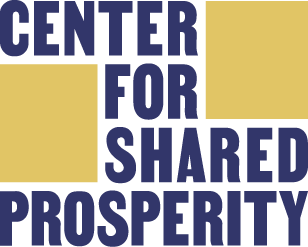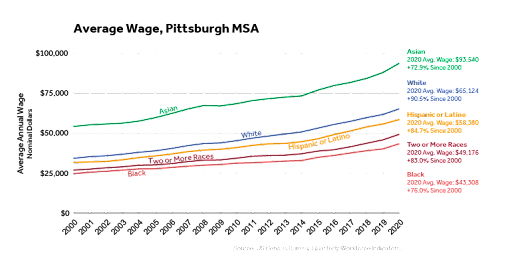Cradle to Livelihood
Background
Wayfinding and support services to break through barriers to equitable attainment of family-sustaining livelihood are critical to a just society. The need for that support starts at early childhood, with engagement and empowerment for parents and caregivers, and continues all the way beyond high school, through trade school and college pathways.
Yet Pittsburgh is a city in which disparities define the economic reality of many residents — especially people of color and specifically Black residents, limiting access to opportunities as people navigate the educational system and enter the workforce. These disparities present themselves in a wide variety of economic data, including data related to workforce, education, housing, and health. These disparities have also been exacerbated by the Covid-19 pandemic, which in addition to affecting people of color more significantly with respect to health outcomes (both nationally and locally) has also had more severe economic consequences for people of color (again, both nationally and locally) and specifically Black residents.
This project seeks to understand the existing networks of organizations, supports, and resources that exist locally in the Pittsburgh area working to reduce and eliminate these disparities, to learn from successful efforts elsewhere, and to design services that address gaps in the current network. Ultimately, the goal of this work is to create a clear pathway from birth through primary and secondary school and on to adulthood for all people in the Pittsburgh region to live prosperous lives — from cradle to livelihood.
Key Indicators
While there are many indicators that speak to the systemic challenges that residents of the Pittsburgh region face in pursuit of economic prosperity, we highlight the following three as indicative of major components of the interrelated systems at play.
Educational Disparity
The education system presents inequities for students of all ages. These inequities begin with childcare and pre-K access, include funding mechanisms for public primary school educations and the corresponding patterns of racial segregation the reinforce disparities in educational resources and outcomes, and eventually lead to disparities in long-term educational attainment. One common way to capture that systemic disparity overall is to view the relative rates at which the adult population of different demographic groups achieves a bachelor’s degree or higher, with white residents and Asian residents far more likely than Black residents to have received a college degree in the region.
Wage Disparity
Black and multiracial workers in the Pittsburgh region have consistently faced wage disparities compared to their white and Asian peers. Further, compared to the White population, those disparities have widened considerably in the last 20 years.
Homeownership Disparity
While it is hard to measure wealth accumulation, one indicator that serves as a common proxy is homeownership — a manifestation of, and pathway towards, wealth. White residents of the area own homes at much higher rates than residents of other racial groups.
Existing efforts/resources
The following list is incomplete, but it highlights several of the key organizations working locally to address educational and workforce disparities in the Pittsburgh region.
Allies for Children
Bridgeway Capital
Communities In School, Pittsburgh-Allegheny County (CISPAC)
Gwen's Girls
Homewood Children's Village
Homewood Children’s Village
National Society of Black Engineers (NSBE)
OnePA
PA Black Conference on Higher Education
Partner4Work
Remake Learning
UPMC center for Social Impact
WorkHardPittsburgh
Project Objectives
The project will focus on the following four elements.
Comprehensively understand the local services and resources currently provided.
Learn about nationally exemplar programs.
Engage with youth and parents to listen to their voices, needs, and desires.
Engage in a place-based process to design support services that are complementary to existing, successful efforts. This could include a specific focus, for example, on early childhood and parental empowerment; or it could include a focus on post-graduation career preparation and follow-through.




